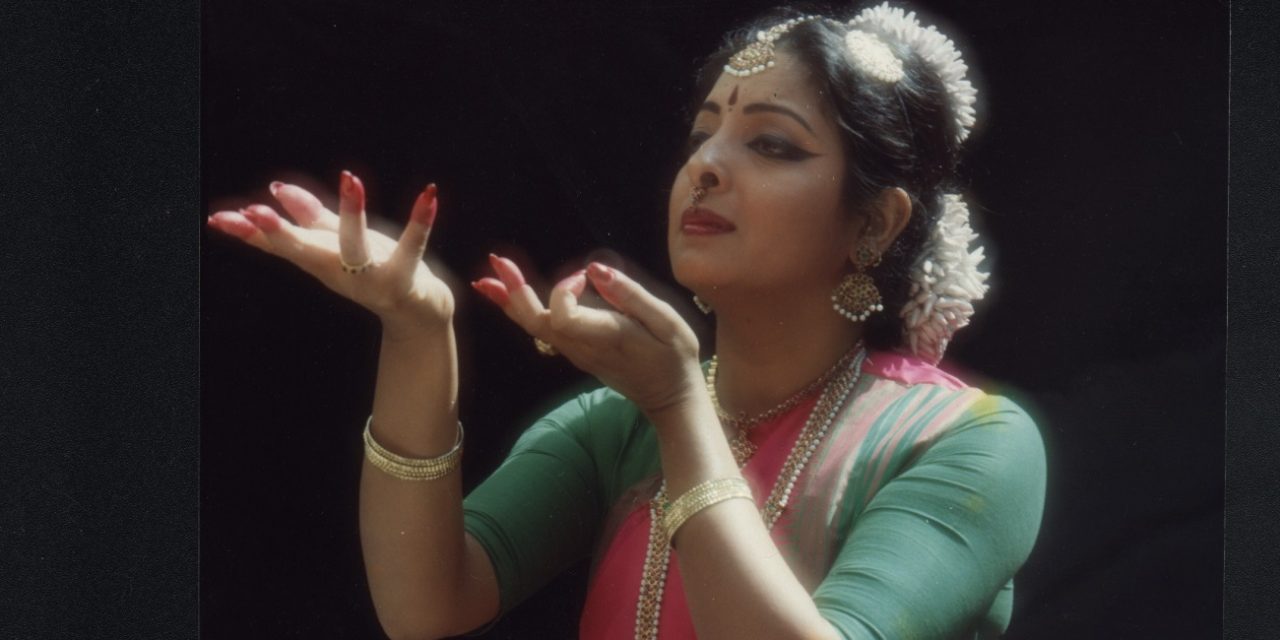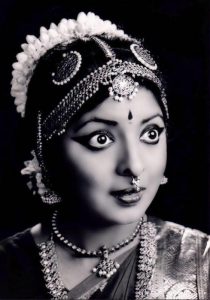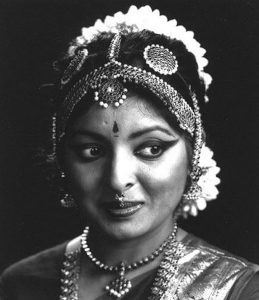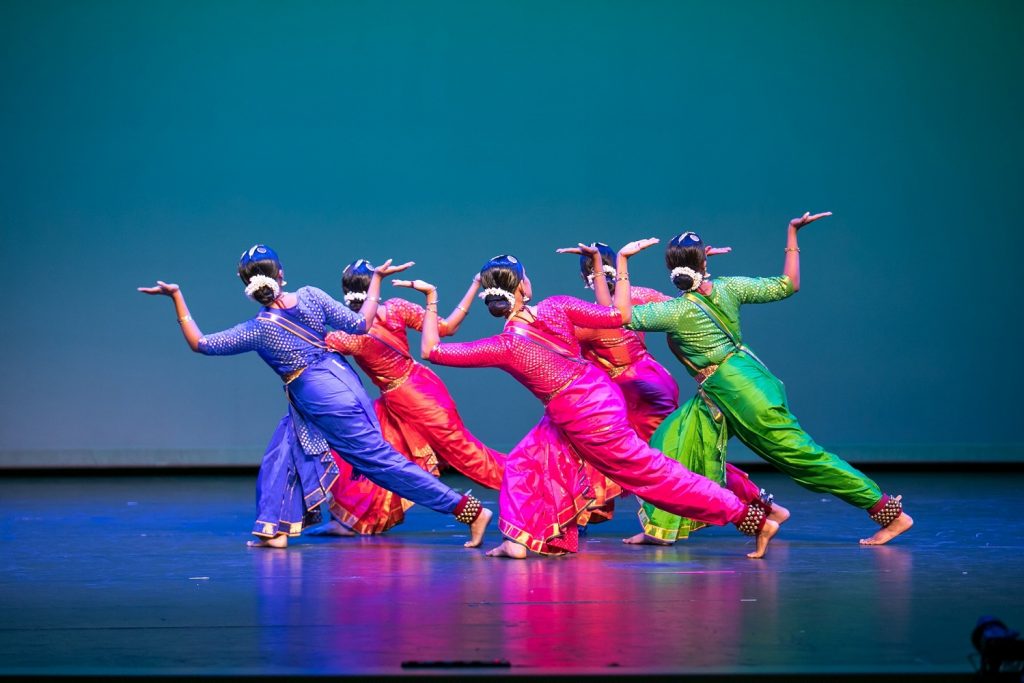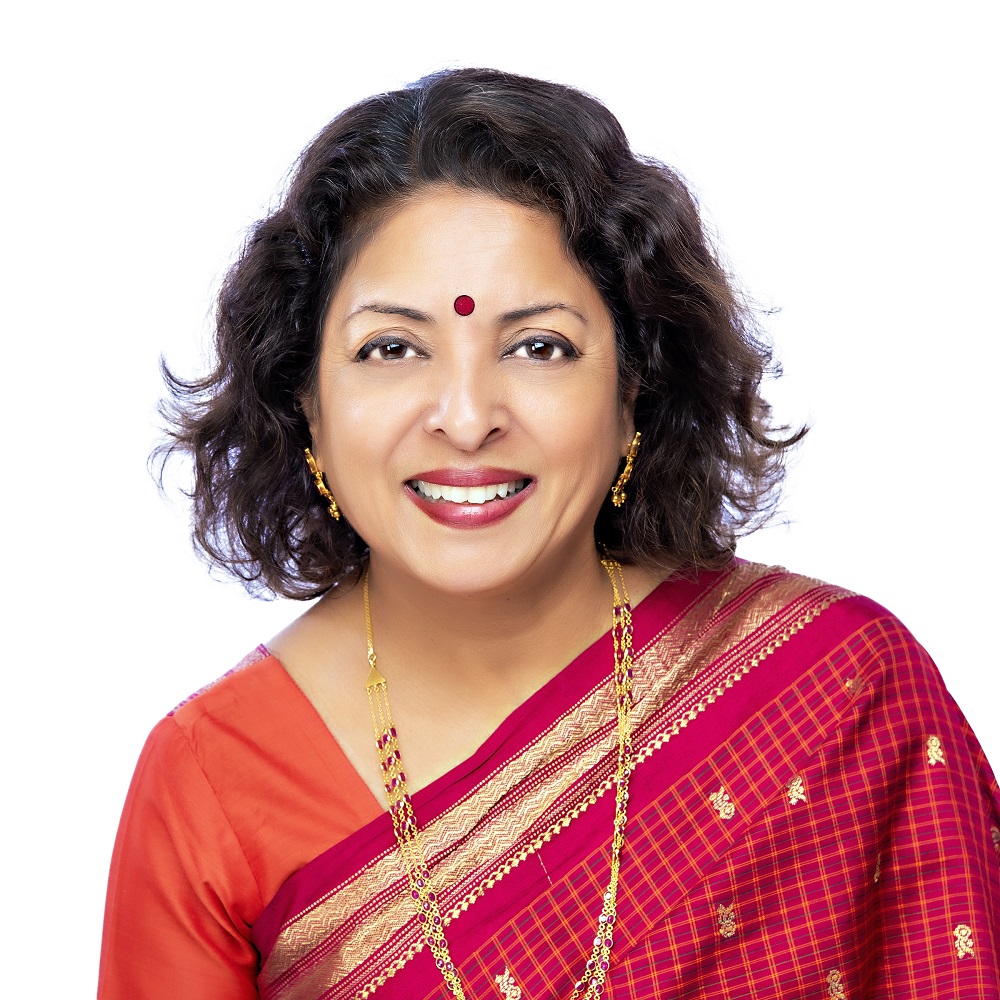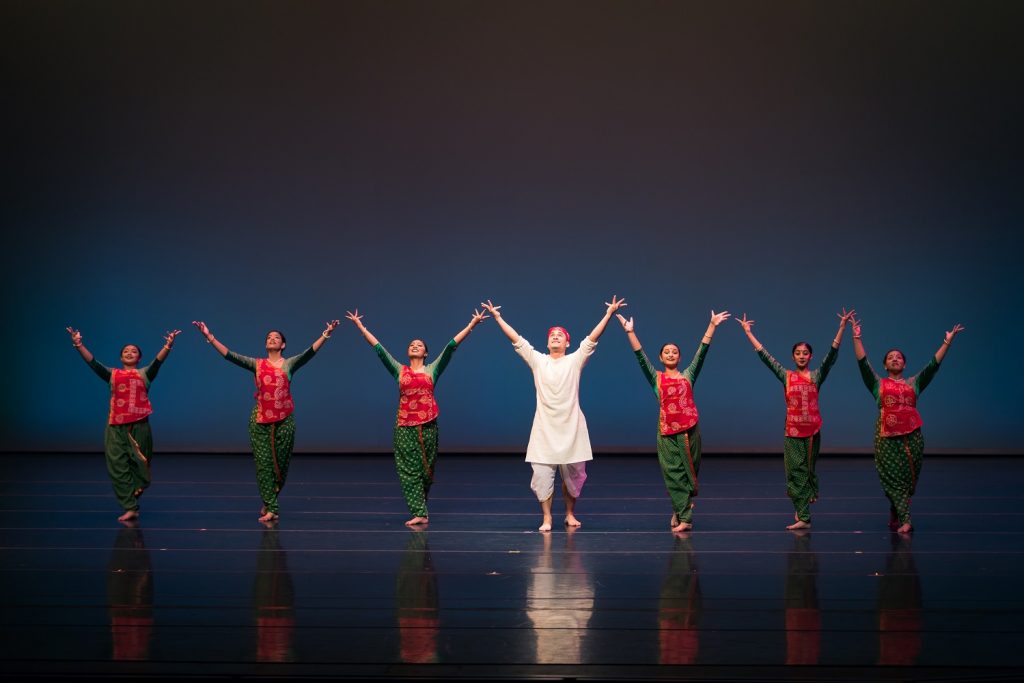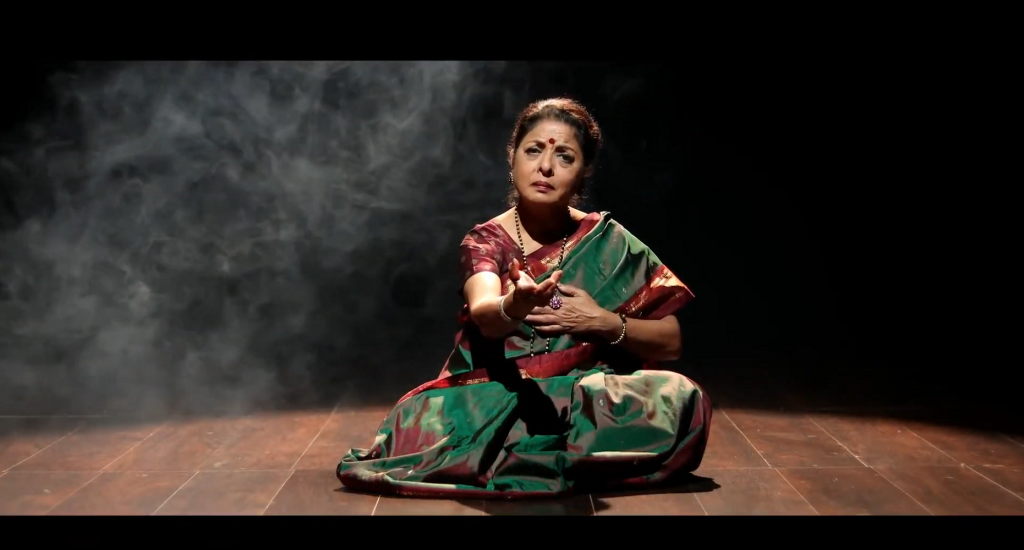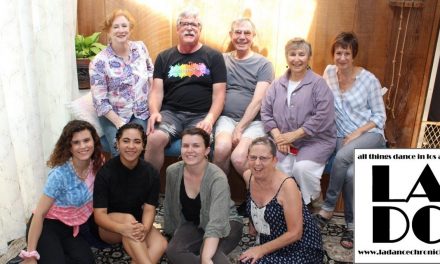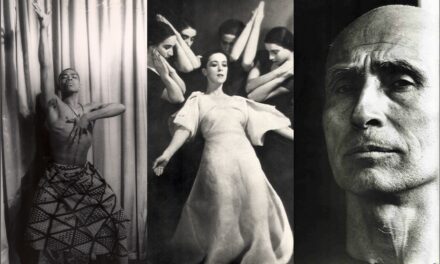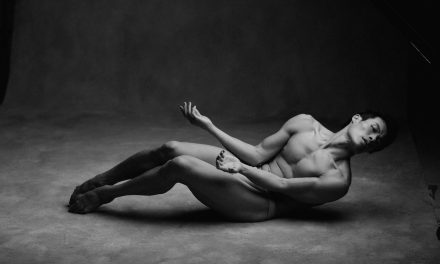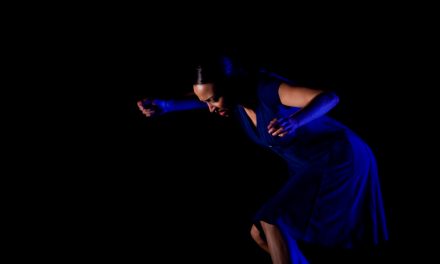Recently Arpana Dance Company performed virtually on Awe and Wonder produced by Donna Sternberg & Dancers. The entire event was excellent, but I was unable to get the performance of Artistic Director Ramya Harishankar out of my mind due to its beauty and powerful statement. The theme of Awe and Wonder was Climate Change and Harishankar’s solo, Bhumika’s Lament, came at the conclusion of the evening. Here, Harishankar chose to portray the Entity Bhumika speaking directly to and questioning those who generally pay reverence to her. It was a unique way for Mother Earth to ask us why we have harmed her after all that she has provided.
Harishankar is a performer and teacher of Bharata Natyam (Bharatanatyam), one of the oldest forms of Indian dance. Bharata means India and Natyam is theater. Bharata is supposedly the sage that qualified the rules of theater and so the dance form is dedicated to him. There is a third way of writing the form that divides it into three words meaning music, rhythm and expression. Over time, these have been combined into one word, but Harishankar writes them as two making it easier for people to pronounce the art form.
She was born in Chennai, the capital of the state of Tamil Nadu on the Bay of Bengal in the south eastern part of India but grew up for the first ten or eleven years in New Delhi. She attended the University of Madras but told me that she learned dance the old fashion way, studying one on one with all her teachers or gurus. There was an institution where Bharata Natyam was redefined during the 1930’s and 40s, but she did not study in a school/college of dance.
At an early age, and with her mother’s encouragement, Harishankar studied for six years in New Delhi. Deciding that she needed to take classes more intensely, Harishankar moved to Chennai to live with her grandmother and began studying with a new guru. Her grandmother knew little about dance because she belonged to a generation where dance was looked upon perhaps, a cabaret type of entertainment and not attended by “good” families. She did, however, educate herself about dance, was supportive and dedicated to her granddaughter’s mentoring.
During this period dancers performed with a live orchestra, a strong bond between the gurus/teachers and the student was critical to understand the choreography and for the guru to be able to conduct the recitals. Her first guru was K.N. Dakshinamurthy but she later began studying with guru Swamimalai Rajaratnam who was known for his musical talent, brisk jathis, elegant nattuvangam and choreography skills. Swamimalai was not his given first name but that of the village where he hailed from, a common naming protocol in Southern India.
Bharata Natyam, previously called Sadhir, is a major form of Indian classical dance that originated in Tamil Nadu and is one of the most evolved of classical dance traditions in India. It has been nurtured in the temples and courts of southern India for several centuries. Through the 19th century the form remained exclusive to Hindu temples, performed as part of prayer rituals or in the evenings as entertainment and artists were funded by the local lords. During the era of colonial British government, however, Sadhir was banned but the Indian community protested against the ban and expanded it outside the temples in the 20th century.
Harishankar explained how Bharata Natyam is constantly evolving and its popularity across the world confirms its status as a global ‘living’ form. She related how she hesitates to use the word ‘dance tradition’ because that would indicate “the same being recreated generation after generation”. She considers Bharata Natyam to be a language that one can use to communicate any thought, idea, story or emotion. “In fact, Abhinaya means ‘to communicate’,” she said.
“Dance, theatre and music in India can be traced back several thousand centuries but it has not been performed the same way. One sees ‘changes’ in the form even in the last century when it moved from the temple courtyards to proscenium spaces, from the devadasi communities to upper caste/class performers, from female dancers exclusively to the numerous male dancers today.” Harishankar stated.
Harishankar spoke more on the history of Bharata Natyam. “There has been a lot of research for the last three or four decades into slowly understanding some of the history. There is a tendency to say that this is an old, divine form that is 2,000 years old. But Natya Sastra, which is the treatise on the theater, dated 2nd century BC.” she explained. “has informed several forms and obviously, there are historical, religious, political, economic and other influential impacts over the years, so one cannot say that what we perform today can be connected to two thousand years ago or any amount of time.”
There are no video records of the early forms of Bharata Natyam to compare how the dancers performed then in relation to present dancers. Harishankar said that even if one looks at recordings of how Bharata Natyam was performed during the 19th century, one can see that it was quite different from how she and others perform it now. “That is why I say what we do now is more modern,” Harishankar said.
During our interview, I asked Harishankar why she was drawn to this particular form of dance as a child. She said that at the time there were six classical dance forms in India, but that this particular form of dance comes from the state or region that her ancestors hail from. Currently, there are approximately 10 classical Indian dance forms in India, Bharata Natyam being the most popular of all the Indian classical dance forms.
In India, the term Natya (theater) includes music, dance and drama. They are integrated and cannot be separated. Harishankar feels that one of the reasons Bharata Natyam has become so popular it is expansive and all-embracing and can be performed to both the northern (Hindustani) and southern (Carnatic) Indian forms of music, which each have their own distinct rhythmic structure as well as interpret songs in any of India’s 25 + languages.
“Part of this may be because in the south,” she said. “the form was able to survive without too much external influence and interruptions.” Northern India went through many invasions from other countries and cultures causing many art forms to be lost or altered to fit the religious culture of the conquerors. “Many of our compositions, even dating back to the 8th century, are still available. We have an incredibly huge repertoire of music and poetry that we can fall back on for interpretation through dance.”
Harishankar had received her undergraduate degree in accounting and business from the University of Madras and was beginning her graduate studies when she began studying with guru Kalanidhi Narayanan. Narayanan was from an upper class family, studied and performed Bharata Natyam until the age of 15 when she gave it up to get married. For the next 35 years she remained out of the world of dance, not even attending a performance. In the 1970s, Narayanan returned to dance as a teacher of Abhinaya, the interpretive aspect of Bharata Natyam where compositions could be erotic making it awkward and challenging for male gurus to teach young dancers, at least in those days. Harishankar began studying with Narayanan in 1975 and it was then that she decided to give up her studies at the university and dance full time. “Abhinaya gave me a voice,” she said. “It was what I was looking for although I didn’t know that I could do that. She opened that door for me.”
At the young age of 14, It was the harsh words of a well-known Indian critic that almost destroyed Harishankar. The critic liked her dancing but stated that her face was “like a piece of wood.” She cried for several days, but when she began studying with Narayanan, she said it was a whole new world and she was no longer wooden faced. Harishankar went on to enjoy a wonderful career, performing solo throughout India and other parts of Asia and Europe. She was never part of a company until she formed her own.
“All my gurus choreographed pieces individually for each of their students, perhaps subconsciously aware of the strengths and weaknesses of each of them. In my generation, we were all soloists,” Harishankar said.
I was curious about the music and rhythmic structure of Bharata Natyam. “Very simply to understand the rhythmic structure,” Harishankar said. “It’s all done mathematically. A simple example would be a certain structure or tala with a cycle of 32 beats, so if you are doing four cycles of 32 that is 128 beats, and you can divide that in any way you can. ” She said that this is how they come up with so many different complex rhythmic systems which tends to be the essence of the North Indian dance style known as Kathak, influenced by its history in the royal courts. Bharata Natyam is not as “flashy” or entirely dependent on the use of the rhythmic structures. According to Harishankar, it’s quality could have more of a reverential feel to it.
My next questions to Harishankar were directed to why she relocated to America and if she moved directly to Irvine, California which is where she and her company are currently based. She said that her husband’s sister had lived in the area since the late 1960s and because they had an opportunity to move here, they did so. “On a whim, really,” she said. They were both young and loved to travel so decided to see if they liked it here with moving back to India always an option. That was in 1982.
When asked what the genesis of her company was, Harishankar said that she began teaching in Irvine to a community of Indian students who had been awaiting her arrival. From there it just grew and she formed her company in 1985 and like the dance form that she teaches and performs, her work has evolved over time.
For Harishankar, dance must have a center of mind, body and spirit, and in India dance was first used as a form of prayer in the sense of dedication. The word Arpana means offering, and Harishankar has always wanted herself and her students to dance with that sense of “offering” it to a higher power. It was from this desire that Harishankar named her group Arpana Dance Company.
Arpana Dance Company has performed in the United States, Europe and two tours of India. Harishankar related that the company did not receive a great deal of compensation in India, but she felt that it was more important that her dancers travel there to share the work they were creating with their friends and family. What money the company did receive was donated to a local charity in India.
For twenty years, Arpana Dance Company has collaborated with the Los Angeles based company Kinnara Taiko. In 2007 the two companies toured India, then in 2011 Japan, performing in Hiroshima, Kure and Nara raising over $20,000 for Tsunami relief. In 2014 the two companies toured together again, this time throughout Hawaii.
Running a dance company in the US is difficult for everyone due to the lack of funding, but I was curious if those difficulties were amplified or worse for a company such as Arpana Dance Company.
“In southern California particularly, there is very limited consciousness of Art or Dance being an integral part of the social structure,” Harishankar said. “Perhaps it is my crazy idealism, [but] I feel one should just be able to dance. Money should not dictate what, when and how you should dance, but I understand the challenge for the average dancer.” She also stated that there is a lot of pressure on first generation Indo-Americans to follow more lucrative professions, to become lawyers, engineers or doctors. Even if these young people did want to pursue dance or music as a career, the opportunity is not there due to the lack of awareness of the importance of the arts to social structures, and therefore, inadequate support and funding.
Harishankar related that colleagues of hers in cities like Chicago, New York and Toronto have received continued funding which allows them to have their own studios and to pay dancers, but in Southern California, she has not received such financial backing.
Harishankar’s work titled Ganga…life as a river did receive a “Creativity” grant from the National Endowment for the Arts and the “Artist support” program of the Fund for Folk Culture, but she has not received regular or on-going financial support.
“Somewhere there is something missing in the fabric as a community, as a society without the awareness of the importance of art” she said. We also discussed that partially due to the vastness of the city of Los Angeles, there is often a lack of a sense of community amongst the dancers and other artists. Harishankar said that it was vastly different in the Bay Area when she was there as a panelist for the Ethnic Dance festival. People paid money to come and watch the auditions. These were not fully produced performances but auditions involving over a hundred companies lasting four days.
I ask Harishankar what future plans she has for herself and her company. She told me that next year she will celebrate 40 years of teaching and the Covid pandemic has expanded her horizons in many ways in respect to teaching online. Before the pandemic she would have refused to do so, but now has become more comfortable with virtual teaching on Zoom and for the past year taught students who reside in Canada and Australia, as well as online workshops for students in India.
The video that Harishankar produced for Awe and Wonder has now been re-edited and retitled Bhumika. Bhumi means earth and explains that Bhumika is a feminine name for Mother Earth. The work is available for viewing online and Harishankar has received wonderful letters of congratulations from colleagues as well as from people she doesn’t even know.
“More importantly,” she said. “We have raised nearly $16000 for marginalized artists in India who are literally dying of starvation.” These artists do not have jobs due to the Covid pandemic raging throughout India, are all in the villages – folk musicians and dancers, shadow puppetry artists, temple musicians, and tribal artists without jobs and who cannot afford to buy food.” Harishankar said that she has collaborators in India who are distributing care packages to these artists purchased from the money raised. I checked online and saw that right now $10,000 dollars equals approximately 723,937.00 Indian rupees. It will help feed many.
“If you can sacrifice one cup of Starbuck coffee,” Harishankar said. “You could feed an entire family in India for a day.”
Harishankar will soon be premiering what she calls Dance Conversations – a retrospective on Indian dance in S. California with people who have been part of her journey over the past 40 years- mentors, collaborators, colleagues and peers. She has recorded 10 episodes of conversations with people in the US, Europe, India and Australia, all of whom have been involved in different facets of her dance journey. This is a personal project for Harishankar; an archival collection of not just her stories but of those she is conversing with – 18 artists that she respects to speak to the evolution of Indian dance throughout the past 40 years in S. California. Dance Conversations will soon be released online free of charge.
The past year and the success of her film Bhumika has given Harishankar the confidence to expand her teaching online and to create more self-challenging works. She can now imagine dances with different types of structures than did before.
Ramya Harishankar left me with much to think about including this provocative question:
“The Arts are embedded into the culture and lifestyle of world class cities – Paris, London, NY etc. Popular and commercial dance tends to permeate LA, mostly. My home town, Chennai, is a UN Cultural Heritage city. That is something I am interested in – how do we create a culturally rich environment truly representative of diverse communities?”
#####
To learn more about Ramya Harishankar, Bharata Natyam and Arpana Dance Company, please click HERE.
To view Harishankar’s film Bhumika (run time 18 mins.), please click HERE. To donate to send aid to artists in India, click HERE.
Written by Jeff Slayton for LA Dance Chronicle.
Featured image: Ramya Harishankar – Nectar – Photo courtesy of the artist

